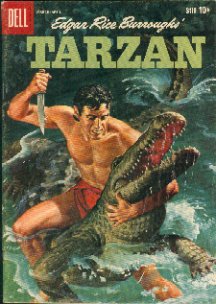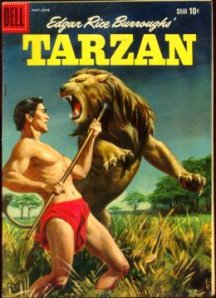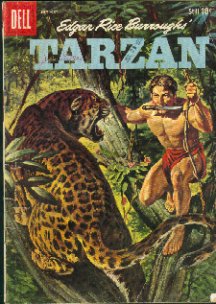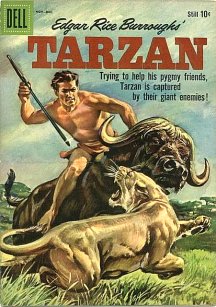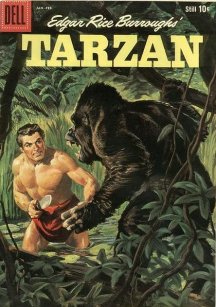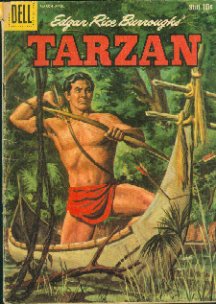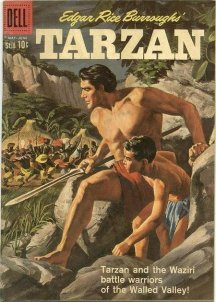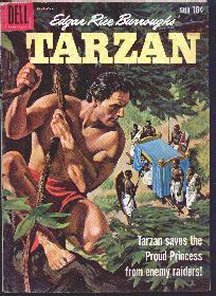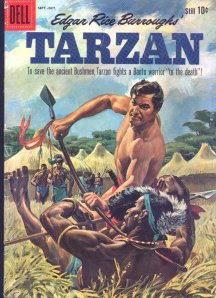.

DELL
#113 July/August 1959 ~ 36 pp. Still 10 cents

READ
IT HERE
Art
interior: Jesse Marsh
2nd
story - unknown illustrator but Marsh-like
Cover
Painting: Morris Gollub
Writer:
Unknown (Gaylord Du Bois - unconfirmed)
Cover:
Painted cover by Morris Gollub
Inside
Front Cover: New subscription advertisement -
2 for
the price of 1 with a free key and coin case - color

1st story “Tarzan
in The Vengeance of N‘gogo”- 15 pp.
Type -- Leopard Men - N’kima
(saves Tarzan)

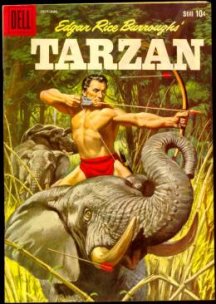 N’kima
watches Tarzan hunt with a rope from a tree over a stream. A native hunter
approaches the waterhole. The witch doctor, N’gogo, and a Leopard Man are
stalking him. Tarzan’s blunt arrow knocks the Leopard Man unconscious.
He ropes N’gogo and pulls him up into the tree. The native hunter runs
away. When Tarzan takes his fetish bag, N’gogo threatens him. The ape-man
burns the Leopard Man’s costume and the objects in the fetish bag. He smashes
the leopard claws. He releases his captives. N’gogo swears revenge.
N’kima
watches Tarzan hunt with a rope from a tree over a stream. A native hunter
approaches the waterhole. The witch doctor, N’gogo, and a Leopard Man are
stalking him. Tarzan’s blunt arrow knocks the Leopard Man unconscious.
He ropes N’gogo and pulls him up into the tree. The native hunter runs
away. When Tarzan takes his fetish bag, N’gogo threatens him. The ape-man
burns the Leopard Man’s costume and the objects in the fetish bag. He smashes
the leopard claws. He releases his captives. N’gogo swears revenge.
N’gogo plans to use Mabula’s
fear of him and the Leopard Society to extract his vengeance. He arrives
at Mabula’s kraal and demands to meet with him alone in his hut. The chief
listens to the witch doctor’s plan. N’gogo threatens him with a death spell
if he does not comply.
The messenger, Ulithi, comes
to Tarzan and tells him that Mabula is ill and only Tarzan can save him.
N’kima accompanies Tarzan to the Mabula Village, but he is too afraid to
enter the chief’s hut. As Tarzan examines the chief, a villager hits him
in the head with a rock, knocking him unconscious. When he awakens, he
is tied with ropes and chained to the center pole. N’kima burrows through
the thatched roof. Tarzan sends him for help.
On his journey N’kima escapes
from the claws of a leopard and the fangs of a hyena. He comes upon a tribe
of great apes. He convinces Thorak that Tarzan is in trouble. Thorak commands
Unga and Urchuk to come with him. N’gogo and the Leopard Men approach the
deserted village. Thorak bites through the ropes on the ape-man’s hands
while Urchuk bites through the leg bindings. They hear the gomangani approaching.
Cautiously N’gogo comes to the door of the hut. Thorak grabs him and throws
him into the Leopard Men. They think Tarzan has changed into an ape. Tarzan
has the apes lift the pole so he can slip the chain underneath it. The
apes think it would be fun to throw the pole with the roof attached over
a cliff. The Leopard Men witness the hut following Tarzan. They believe
that the ape-man’s magic is too strong for them. They tear off their costumes
and flee. The apes throw the roof over the cliff. Tarzan breaks the chain
around his neck.
Days later in the trees Tarzan
overhears natives talking about the mysterious death of N’gogo and how
they believe that the reign of terror of the Leopard Men is over. Tarzan
tells N’kima that Mabula is afraid of him. N’kima says that everyone is
afraid of Tarzan except N’kima. End.
The featured
story is a good story but the drawings are of a lesser quality. The Leopard
Men costumes are weak as the Leopard Men themselves. They are merely pawns
to the evil N’gogo. The size perspective of N’kima is distracting at times.
The witch doctor is a good villain and has a great plan to exact his revenge
on the ape-man for destroying his fetish items. N’kima is the hero if the
story. At times he displays the personality that was so wonderfully depicted
in other Dell stories. However, in this story he has to be the hero so
he is less N’kima-like. He is still good but not the greatness of previous
tales. Tarzan is knocked unconscious once again. N’kima brings the apes
to chew through the ropes. Once that is accomplished, Tarzan should be
able to break the chain around is neck as he will do later in the story.
But Tarzan doesn’t break the chain instead he has the apes raise the pole
so that he can slip the chain under it. Of course, this is only necessary
to have the scene of the hut following Tarzan. This is a great scene and
puts great fear into the Leopard Men. This is critical to the story. At
the end of the story we learn third hand about the death of N’gogo. This
is a bit anticlimactic.

“Along a Jungle Trail” -- 104th
text story -- 1 page - one illustration

2nd story “Tarzan
in Invasion from Pal-ul-don” - 9 pp.
Type -- Terribs - Giant Otters

Tarzan and Boy train the giant
otters, Zip and Zoom, in the pool near the tree house. Isilo brings the
bad news that people are being snatched from their canoes by crocodiles
with hands. Tarzan realizes that the Terribs have invaded the area. He
instructs Boy to keep Zoom with him at all times. He takes Zip with him
to investigate.
Boy takes Zoom to Muviro’s
kraal. He talks the reluctant Dombie into going fishing with him. Dombie
spears a fish with his trident. Zoom steals the fish away from him. Dombie
falls into the river, toppling the canoe. They get the canoe upright. A
Terribs riding a Gorobar rises, grabs Dombie, and dives underwater. Boy
hollers for Zoom as he dives in the river. The Terribs heads for his underwater
cave. He releases Dombie as Zoom approaches. The Terribs darts into his
cave opening. Boy pulls the unconscious Dombie to the surface and administers
artificial respiration. Zoom surfaces with crocodile armor in its mouth.
Tarzan, Muviro, and the Waziri
come upon the scene. Boy explains what happened to Dombie. Tarzan informs
the Waziri that the Terribs have air holes on the surface. The ape-man
has Zoom search this side of the river. He and Zip canoe to the other side
to search there. Zoom and Zip find openings. The Waziri spear the Terribs
through the holes driving them out into the river. They chase them to the
falls and watch them go over the edge. Tarzan fears that other Terribs
may try to enter Tarzan country. Muviro says that they will be watchful
and ready. End.
The second
story is a great Terribs story. It is not explained why the Terribs have
left Pal-ul-don, but it will give the writers a terrific opportunity to
use their best villain in future stories. One would hope that the writers
would take full advantage of this stroke of genius by placing them near
Tarzan. The giant otters always seem to come in pairs and this is no exception.
However, they have new names - Zip and Zoom. None of the otter pairs last
long. They tend to appear in one story and are replaced by a new pair the
next time otters are needed. The artist is probably NOT Marsh. This artist
conforms to what one expects of Marsh’s Tarzan and Boy. There are clues,
which makes one think that is not Marsh. The heavy use of hatching marks
especially on the natives is not typical of Marsh. The rendering of the
full body of Boy is more revealing than a typical Marsh rendering. The
Waziri are dressed differently than the usual Marsh drawings. Muviro, himself,
is more Negroid in appearance than the usual Marsh rendering. This artist
also has some perspective problems when dealing with giant creatures in
comparison to normal size people. But Marsh also demonstrated perspective
problems with N’kima in the last couple of issues. Despite the drawing
faults, the story makes this an outstanding issue.

“Brothers of the Spear”
-- 89th -- 6 pages
New Advertisement --
Daisy Manufacturing Company - 1 page - in color
Inside Back Cover:
New advertisement - Daisy Manufacturing Company -
tied in with previous page
advertisement - color
Back Cover: New advertisement
Kraft Fudgies -
similar to previous issue
inside front cover advertisement - color



